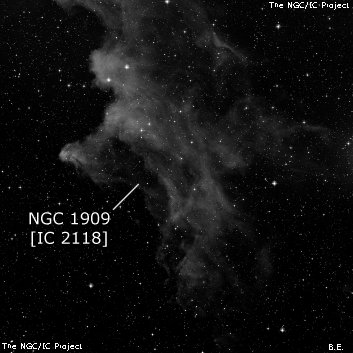NGC/IC Project Restoration Effort
(This is a very very beta version)
NGC1909


Basic Information
Location and Magnitude
Right Ascension: 5:4:54.0
Declination: -7:15:0
Constellation: ERI
Visual Magnitude:
Historic Information
Discoverer: Herschel W.
Year of discovery: 1786
Discovery aperture: 18.7
Observational
Summary description: eL, strongly susp (2° in PD)
Sub-type: RN
Corwin's Notes
=====
NGC 1909. WH has one observation of this "Strongly suspected nebulosity of
very great extent." He makes its size "Not less than 2 deg 11 arcmin of PD
and 26 sec of RA in time." These numbers come from his offsets from Rigel:
11m 09s east to 11m 35s east, and 1 deg 19 arcmin north to 52 arcmin south.
While this whole area is covered with a very diffused, very low surface
brightness nebulosity, I do not see anything that WH could have seen easily.
In particular, there is no nebula stretched out north to south as WH
describes.
However, at about the right distance WEST of Rigel, there is such a nebula,
IC 2118. It is bright enough that WH might have seen it during his sweeps,
and it more or less matches his description. So, I am going to suggest,
pending visual confirmation, that IC 2118 is the object WH found, and that he
somehow confused "east" and "west" in his log book.
That is what I wrote in the 1990s when I went over the field on the first
Palomar Sky Survey prints. However, I now have CH's fair copies of the sweeps
available and find that my idea of the nebulosity west of Rigel being WH's
object is impossible. WH observed the nebulosity at least 11 minutes AFTER
Rigel had left the field, so NGC 1909 cannot be west of the star. So, there
is no possibility that WH's object is IC 2118.
So what DID WH see? Probably nothing beyond optical (reflections of bright
stars, fogging of his eyepiece or mirror, faint clouds or sky glow) or
physiological/psychological (aberrations within his eye, fatigue, hunger, etc)
effects.
Steve's Notes
=====
NGC 1909
See observing notes for IC 2118.



